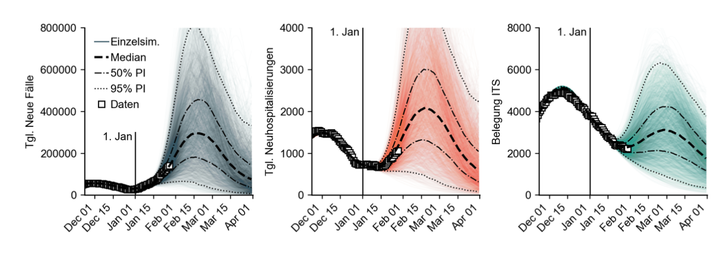New Preprint Out: Modeling the impact of the Omicron infection wave in Germany

Abstract
In November 2021, the first case of SARS-CoV-2 “variant of concern” (VOC) B.1.1.529 (“Omicron”) was reported in Germany, alongside global reports of reduced vaccine efficacy against infections with this variant. The potential threat posed by the rapid spread of this variant in Germany remained, at the time, elusive. We developed a variant-dependent population-averaged susceptible-exposed-infected-recovered (SEIR) infectious disease model. The model was calibrated on the observed fixation dynamics of the Omicron variant in December 2021, and allowed us to estimate potential courses of upcoming infection waves in Germany, focusing on the corresponding burden on intensive care units (ICUs) and the efficacy of contact reduction strategies. A maximum median incidence of approximately 300 000 (50% PI in 1000: [181,454], 95% PI in 1000: [55,804]) reported cases per day was expected with the median peak occurring in the mid of February 2022, reaching a cumulative Omicron case count of 16.5 million (50% PI in mio: [11.4, 21.3], 95% PI in mio: [4.1, 27.9]) until Apr 1, 2022. These figures were in line with the actual Omicron waves that were subsequently observed in Germany with respective peaks occurring in mid February (peak: 191k daily new cases) and mid March (peak: 230k daily new cases), cumulatively infecting 14.8 million individuals during the study period. The model peak incidence was observed to be highly sensitive to variations in the assumed generation time and decreased with shorter generation time. Low contact reductions were expected to lead to containment. Early, strict, and short contact reductions could have led to a strong “rebound” effect with high incidences after the end of the respective non-pharmaceutical interventions. Higher vaccine uptake would have led to a lower outbreak size. To ensure that ICU occupancy remained below maximum capacity, a relative risk of requiring ICU care of 10%–20% was necessary (after infection with Omicron vs. infection with Delta). We expected a large cumulative number of infections with the VOC Omicron in Germany with ICU occupancy likely remaining below capacity nevertheless, even without additional non-pharmaceutical interventions. Our estimates were in line with the retrospectively observed waves. The results presented here informed legislation in Germany. The methodology developed in this study might be used to estimate the impact of future waves of COVID-19 or other infectious diseases.